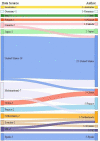Identifying novel subgroups in heart failure patients with unsupervised machine learning: A scoping review
- PMID: 35935639
- PMCID: PMC9353556
- DOI: 10.3389/fcvm.2022.895836
Identifying novel subgroups in heart failure patients with unsupervised machine learning: A scoping review
Abstract
Background: Heart failure is currently divided into three main forms, HFrEF, HFpEF, and HFmrEF, but its etiology is diverse and highly heterogeneous. Many studies reported a variety of novel subgroups in heart failure patients, with unsupervised machine learning methods. The aim of this scoping review is to provide insights into how these techniques can diagnose and manage HF faster and better, thus providing direction for future research and facilitating its routine use in clinical practice.
Methods: The review was performed following PRISMA-SCR guideline. We searched the PubMed database for eligible publications. Studies were included if they defined new subgroups in HF patients using clustering analysis methods, and excluded if they are (1) Reviews, commentary, or editorials, (2) Studies not about defining new sub-types, or (3) Studies not using unsupervised algorithms. All study screening and data extraction were conducted independently by two investigators and narrative integration of data extracted from included studies was performed.
Results: Of the 498 studies identified, 47 were included in the analysis. Most studies (61.7%) were published in 2020 and later. The largest number of studies (46.8%) coming from the United States, and most of the studies were authored and included in the same country. The most commonly used machine learning method was hierarchical cluster analysis (46.8%), the most commonly used cluster variable type was comorbidity (61.7%), and the least used cluster variable type was genomics (12.8%). Most of the studies used data sets of less than 500 patients (48.9%), and the sample size had negative correlation with the number of clustering variables. The majority of studies (85.1%) assessed the association between cluster grouping and at least one outcomes, with death and hospitalization being the most commonly used outcome measures.
Conclusion: This scoping review provides an overview of recent studies proposing novel HF subgroups based on clustering analysis. Differences were found in study design, study population, clustering methods and variables, and outcomes of interests, and we provided insights into how these studies were conducted and identify the knowledge gaps to guide future research.
Keywords: clustering analysis; heart failure; machine learning; scoping review; subtype.
Copyright © 2022 Sun, Guo, Wang, Wang, Ding, He and Guan.
Conflict of interest statement
The authors declare that the research was conducted in the absence of any commercial or financial relationships that could be construed as a potential conflict of interest.
Figures






Similar articles
-
Comparison of Unsupervised Machine Learning Approaches for Cluster Analysis to Define Subgroups of Heart Failure with Preserved Ejection Fraction with Different Outcomes.Bioengineering (Basel). 2022 Apr 16;9(4):175. doi: 10.3390/bioengineering9040175. Bioengineering (Basel). 2022. PMID: 35447735 Free PMC article.
-
The Role of Machine Learning in Diagnosing Bipolar Disorder: Scoping Review.J Med Internet Res. 2021 Nov 19;23(11):e29749. doi: 10.2196/29749. J Med Internet Res. 2021. PMID: 34806996 Free PMC article.
-
Identifying Phenogroups in patients with subclinical diastolic dysfunction using unsupervised statistical learning.BMC Cardiovasc Disord. 2020 Aug 14;20(1):367. doi: 10.1186/s12872-020-01620-z. BMC Cardiovasc Disord. 2020. PMID: 32795252 Free PMC article.
-
Phenotyping heart failure using model-based analysis and physiology-informed machine learning.J Physiol. 2021 Nov;599(22):4991-5013. doi: 10.1113/JP281845. Epub 2021 Oct 18. J Physiol. 2021. PMID: 34510457 Free PMC article.
-
Analytical methods for identifying sequences of utilization in health data: a scoping review.BMC Med Res Methodol. 2023 Sep 27;23(1):212. doi: 10.1186/s12874-023-02019-y. BMC Med Res Methodol. 2023. PMID: 37759162 Free PMC article.
Cited by
-
Heterogeneity in Heart Failure with Preserved Ejection Fraction: A Systematic Review of Phenotypic Classifications and Clinical Implications.J Clin Med. 2025 Jul 8;14(14):4820. doi: 10.3390/jcm14144820. J Clin Med. 2025. PMID: 40725513 Free PMC article. Review.
-
Common non-cardiovascular multimorbidity groupings and clinical outcomes in older adults with major cardiovascular disease.J Am Geriatr Soc. 2023 Oct;71(10):3179-3188. doi: 10.1111/jgs.18479. Epub 2023 Jun 24. J Am Geriatr Soc. 2023. PMID: 37354026 Free PMC article.
-
Unsupervised machine learning identifies biomarkers of disease progression in post-kala-azar dermal leishmaniasis in Sudan.PLoS Negl Trop Dis. 2025 Mar 11;19(3):e0012924. doi: 10.1371/journal.pntd.0012924. eCollection 2025 Mar. PLoS Negl Trop Dis. 2025. PMID: 40067811 Free PMC article.
-
Discovering Distinct Phenotypical Clusters in Heart Failure Across the Ejection Fraction Spectrum: a Systematic Review.Curr Heart Fail Rep. 2023 Oct;20(5):333-349. doi: 10.1007/s11897-023-00615-z. Epub 2023 Jul 21. Curr Heart Fail Rep. 2023. PMID: 37477803 Free PMC article.
-
Scoping Meta-Review of Methods Used to Assess Artificial Intelligence-Based Medical Devices for Heart Failure.Bioengineering (Basel). 2023 Sep 22;10(10):1109. doi: 10.3390/bioengineering10101109. Bioengineering (Basel). 2023. PMID: 37892839 Free PMC article.
References
-
- Bozkurt B, Coats AJS, Tsutsui H, Abdelhamid CM, Adamopoulos S, Albert N, et al. Universal definition and classification of heart failure: a report of the Heart Failure Society of America, Heart Failure Association of the European Society of Cardiology, Japanese Heart Failure Society and Writing Committee of the Universal Definition of Heart Failure: endorsed by the Canadian Heart Failure Society, Heart Failure Association of India, Cardiac Society of Australia and New Zealand, and Chinese Heart Failure Association. Eur J Heart Fail. (2021) 23:352–80. 10.1002/ejhf.2115 - DOI - PubMed
-
- Warbrick I, Rabkin SW. Effect of the peptides relaxin, neuregulin, ghrelin and glucagon-like peptide-1, on cardiomyocyte factors involved in the molecular mechanisms leading to diastolic dysfunction and/or heart failure with preserved ejection fraction. Peptides. (2019) 111:33–41. 10.1016/j.peptides.2018.05.009 - DOI - PubMed
Publication types
LinkOut - more resources
Full Text Sources
Research Materials
Miscellaneous

